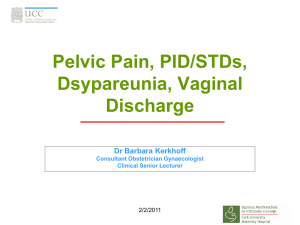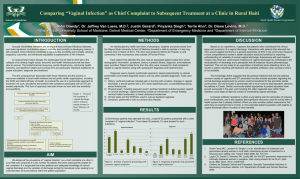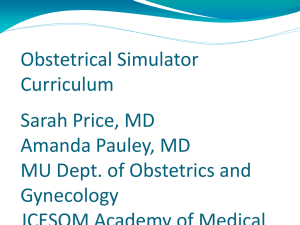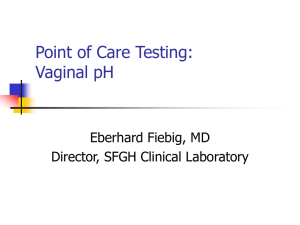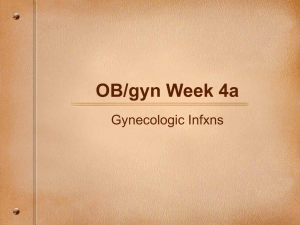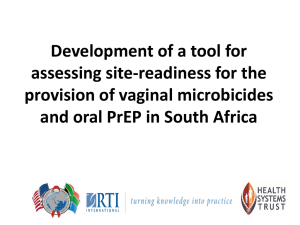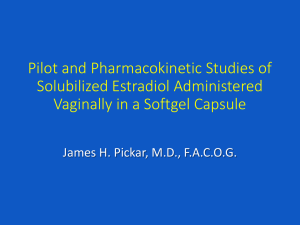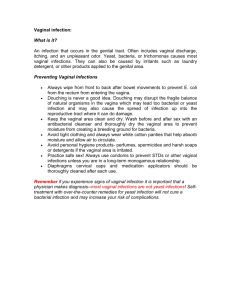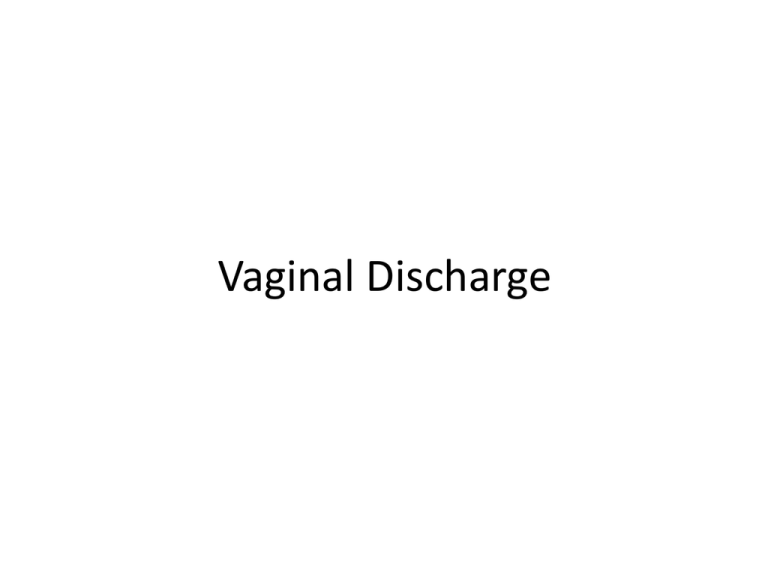
Vaginal Discharge
Common Causes
•
•
•
•
•
Physiological
Candida
Bacterial Vaginosis
STI
Non infective causes ( ectopy, Foreign Body,
Malignancy)
Normal Vaginal flora
•
•
•
•
•
Lactobacilli
Anaerobes
Diptheroids
Coagulase negative staphylococci
Alpha haemolytic streptococcus
Overgrowth of normal vaginal flora
• Candida Albicans
• Staphylococcus Aureus
• Group B Strep ( Strep. Agalactiae)
Commonest causes of altered
vaginal discharge
In women of reproductive age
Vaginal discharge – infective causes
Non STI
STI
BV
Candida
•
•
•
•
Chlamydia trachomatis
N gonorrhoeae
Trichomonas vaginalis
Herpes Simplex
Non Infective Causes of Vaginal
Discharge
•
•
•
•
•
Foreign Body
Cervical polyp/ectopy
Fistulae
Allergic reactions
Personal Hygiene
Bacterial Vaginosis
• Commonest cause of abnormal discharge in
women of reproductive age
• Can occur & remit spontaneously
• Not an STI but link with sexual behaviour
Bacterial Vaginosis
• Overgrowth of mixed anaerobic organisms
replacing Lactobacilli
• Increase in vaginal PH > 4.5
Bacterial Vaginosis
• Gardenerella (Commensal in 30-40% of
asymptomatic women) commonly found
• Prevotella
• Mycoplasma hominis
• Mobiluncus
Vulvo-vaginal Candidiasis
• Overgrowth of yeasts
• Candida Albicans – 70-90%
• Candida Glabrata – 10-30%
Vulvo-Vaginal Candidiasis
•
•
•
•
•
Only treat if symptomatic
Often precipitated by use of antibiotics
Diabetes
Immunocompromise
NOT associated with tampons/sanitary towels
Chlamydia trachomatis
• Most common bacterial STI in the UK
• Asymptomatic in 70 % of women
Chlamydia Trachomatis
•
•
•
•
•
•
Vaginal discharge – cervicitis
Post coital bleeding
Intermenstrual bleeding
Lower abdominal pain
Dyspareunia
Dysuria
Trichomonas Vaginalis
• Vaginal Discharge + Dysuria
• STI
• Rarer than BV or VVC
Management of a lady with vaginal
discharge
• Clinical & Sexual History ( Vaginal Discharge is
a poor predictor of STI)
Management of a lady with vaginal
discharge
• Assessment of Symptoms
• Characteristics of the
discharge
• What has changed
• Onset
• Duration
• Odour
• Cyclical changes
• Colour
• Consistency
• Exacerbating factors
Vaginal Discharge
• Associated Symptoms
•
•
•
•
• Upper Genital Tract
disease
Itching
Dyspareunia
Vulval/Vaginal Pain
Dysuria
• Abnormal bleeding
• Pelvic/Abdominal Pain
• Fever
Vaginal Discharge
• Dermatological conditions ( Lichen Planus) –
superficial dyspareunia & itch (RCOG
Guidance on Vulval Disease)
• Enquire re OTC Rx of VVC ( Women are not
good at self diagnosis)
• Examination & Swabs
Bacterial Vaginosis
Initial cure rates 70-80%
Clindamycin & Metronidazole – comparable
efficacy
Bacterial Vaginosis
• 1st Line Rx – oral Metronidazole ( less
expensive than vaginal preparations)
• Metronidazole safer than oral Clindamycin
(pseudo-membranous colitis)
• Acidifying gels may prevent recurrence
• Rx of male partners ineffective in recurrence
prevention
• Consider Rx female partners
Vulvo-Vaginal Candidiasis
• Rx with oral or vaginal antifungals (cure rate –
80%)
• No data to support Rx or screening of partners
• Vaginal & oral Rx – equally effective
• Vulval symptoms – topical antifungals
Trichomonas Vaginalis
• 1st Line Rx – oral Metronidazole
• Rx partners
Recurrent Vaginal Discharge
• REFER TO THE GUM CLINIC
Recurrent Bacterial Vaginosis
• Median recurrence rate – 58 % after
treatment
• Risk Factors : New/multiple partners, oral
sex, Cu – IUCD
• COCs & condoms reduce the risk of BV
Recurrent Bacterial Vaginosis
• Optimal Rx of recurrence has not been
established
• Twice weekly Metrondiazole gel ( only 33%
remained recurrence-free 12 months after
stopping)
• Acidifying gels – 2 lactic acid vaginal products
available in the UK
Recurrent Vulvo-Vaginal Candidiasis
• 4 or more episodes of symptomatic,
mycologically proven VVC in 1 year
• Suppression & Maintenance treatment
POLYCYSTIC OVARIES
Prevalence 5-10%
Polycystic Ovary Syndrome (PCOS)
• Hyperinsulinaemia
• Glucose intolerance
• Metabolic syndrome
Macroscopically – ovaries enlarged & lobular
Seen in 30 % of women presenting with infertility
Atretic follicles, theca cell hyperplasia & generalised
increase in stroma
Disruption of regular ovulatory processes
Hyperandrogenaemia
Raised LH levels & altered LH:FSH ratio
Peripheral distribution of multiple subcapsular cysts
USS appearance NOT specific for PCOS
PCOS
• 20 % of self selected normal women had PCOS
on scan
• 5 % of the general population is hirsute
• 75% of women with secondary amenorrhoea
fulfil diagnostic criteria for PCOS
PCOS – Clinical Features
•
•
•
•
•
•
•
Onset between 15-25 years of age
Infrequent cycles
Hirsutism
Acne
Acanthosis Nigricans
Obesity
Frank virilisation does NOT appear in PCOS
Described in medical literature in the 1800s
John Sampson(1927) introduced the term endometriosis – retrograde
flow of endometrial tissue through the fallopian tubes & into the
abdominal cavity as the primary cause of the disease
Treatment of PCOS
• Laparoscopic cauterisation of ovaries
• Ovulation Induction ( for Infertility)
• Oestrogen + Cyproterone acetate (for
acne/hirsuitism)
• Metformin ( helps weight loss & ovulation)
• Spironolactone (50-100mg/day) – anti androgen
• Diet & lifestyle
• Cosmetic measures
Endometriosis
•
•
•
•
Prevalence – widely varying figures
10 % of women in the reproductive age group
25-35% of infertile women
4 per 1000 women aged 15-64 hospitalised
each year
• Does not occur before menarche
• Not confined to nulliparous women
Endometriosis – Symptoms & Signs
•
•
•
•
Dysmenorrhoea
Dyspareunia
Diffuse pelvic pain
Symptoms from rectal/urethral/bladder
involvement
• Low back pain
• Infertility associated with above symptoms
• Menstrual dysfunction not increased
Endometriosis – Symptoms & Signs
DD
Chronic pelvic pain
Fibromyalgia
Depression
IBS
Interstitial cystitis
PID
Fibroids
Ovarian Cysts
Pelvic Pain – different presentations
• 15-16 year old with severe dysmenorrhoea
• 35 year old post laparoscopic sterilisation –
pain since she stopped the COC
• Pain associated with menstruation or may be
non cyclic
• Endometriosis may co exist with other
conditions
• In women < 25 years think of STIs
Diagnosis of Endometriosis
Laparoscopy – both diagnosis & treatment
USS
Chocolate cyst of left ovary (Dr Malpani’s blog)
Chocolate cysts tend to be complex & have a ground glass appearance
Relationship between pain & endometriosis unclear
Classic blue or black powder burn appearance
Lesions can be red, black, blue or white & non pigmented
Tan, creamy, fresh appearing endometrium can also be observed
Ovary – most common site for implants & adhesions
Distribution of endometriosis may be widespread – anteriorly &
posteriorly over the broad ligament & cul-de-sac
Treatment of endometriosis
•
•
•
•
Pain relief
Concern re cancer
Recurrence of cyst/endometriosis
Fertility
Medical treatment of Endometriosis
•
•
•
•
•
•
•
•
NSAIDs
COC
DMPA
Provera
GnRH agonists ( add back HRT)
Transvaginal Danazole ( low dose 50-100mg)
Watchful expectancy
AVOID POLYLAPAROSCOPY

